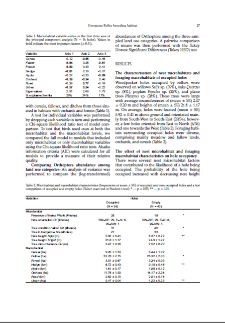
Object
Title: Effects of Forest Management on Three-toed Woodpecker Picoides tridactylus Distribution in the Białowieża Forest (NE Poland): Conservation Implications
Creator:
Wesołwski, Tomasz ; Czeszczewik, Dorota ; Rowiński, Patryk
Date issued/created:
Resource type:
Subtitle:
Wpływ gospodarki leśnej na rozmieszczenie dzięcioła trójpalczastego w Puszczy Białowieskiej: konsekwencje dla ochrony gatunku ; Effects of forest management on Three-toed Woodpecker
Contributor:
Museum and Institute of Zoology, Polish Academy of Sciences
Publisher:
Museum and Institute of Zoology, Polish Academy of Sciences
Place of publishing:
Description:
Type of object:
Abstract:
Distribution of Three-toed Woodpeckers and that of dead wood were mapped in two fragments of the Białowieża National Park (BNP) differing in their management history — primeval (old-growth stands of natural origin, no human intervention) and logged (as the former but subject to 80 years of commercial forestry). Data were collected during the breeding seasons 1999–2001. In the end of April 2000, the whole BNP was systematically searched; playbacks of drumming were used to enhance detection of birds. Presence/absence of Three-toed Woodpeckers and of dead wood (standing and downed Norway spruces and snags of other trees) were recorded within each forest sub-compartments (ca. 28 ha). Data from censuses done in smaller plots in 1975–1999 showed that in the primeval forest the woodpeckers bred twice more frequently in swampy and coniferous forests than in the oak-hornbeam habitat. These preferred habitat types covered larger areas in the logged fragment than in the primeval part (66% vs. 41%). Yet despite this, Three-toed Woodpeckers were recorded there over twice less frequently (14% of 176 sub-compartments) than in the primeval (36% of 164 sub-compartments) part. These differences followed sharp contrasts in the dead wood availability; all but one sub-compartments in the primeval fragment contained some form of dead wood, whereas dead spruces were missing in almost 30% of sub-compartments in the logged part. This was the effect of continuous “sanitary” logging, purposeful removal of dying and dead spruces from the Forest. To restore Three-toed Woodpecker habitats it is necessary to ban removal of dead spruces in the managed part of BNP. However, the BNP area is too small, to assure the long-term survival of the Białowieża Forest population. To achieve this, it is necessary to resign from removal of dying and dead spruces in the whole Polish part of the Białowieża Forest (600 km2). This would create breeding habitat for a maximum 260–320 pairs.
Relation:
Volume:
Issue:
Start page:
End page:
Detailed Resource Type:
Format:
Resource Identifier:
oai:rcin.org.pl:55532 ; 10.3161/068.040.0111
Source:
MiIZ PAN, call no. P.257 ; MiIZ PAN, call no. P.4568 ; click here to follow the link
Language:
Language of abstract:
Rights:
Terms of use:
Copyright-protected material. May be used within the limits of statutory user freedoms
Digitizing institution:
Museum and Institute of Zoology of the Polish Academy of Sciences
Original in:
Library of the Museum and Institute of Zoology of the Polish Academy of Sciences
Access:
Object collections:
- Museum and Institute of Zoology PAS > Scientific Journals
- Museum and Institute of Zoology PAS > MIZ PAN Publications > Acta Ornithologica
Last modified:
Oct 2, 2020
In our library since:
Jul 28, 2015
Number of object content downloads / hits:
33
All available object's versions:
https://rcin.org.pl/miiz/publication/75762
Show description in RDF format:
Show description in RDFa format:
Show description in OAI-PMH format:
Objects Similar
Wesołowski, Tomasz (1950– ) Tomiałojć, Ludwik (1939– ) Mitrus, Cezary Rowiński, Patryk Czeszczewik, Dorota
Wesołowski, Tomasz Rowiński, Patryk Mitrus, Cezary Czeszczewik, Dorota
An expanded scale for the assessment of fatness in great tits Parus major in the non-breeding period
Nowakowski, Jarosław K. Rowiński, Patryk
Nowakowski, Jarosław K. Rowiński, Patryk
Mitrus, Cezary Walankiewicz, Wiesław Czeszczewik, Dorota Jabłoński, Piotr M.
Walankiewicz, Wiesław Czeszczewik, Dorota Mitrus, Cezary Szymura, Arkadiusz
Walankiewicz, Wiesław Mitrus, Cezary Czeszczewik, Dorota Jabłoński, Piotr M.
Skubała, Piotr Duras, Marta

 INSTYTUT ARCHEOLOGII I ETNOLOGII POLSKIEJ AKADEMII NAUK
INSTYTUT ARCHEOLOGII I ETNOLOGII POLSKIEJ AKADEMII NAUK
 INSTYTUT BADAŃ LITERACKICH POLSKIEJ AKADEMII NAUK
INSTYTUT BADAŃ LITERACKICH POLSKIEJ AKADEMII NAUK
 INSTYTUT BADAWCZY LEŚNICTWA
INSTYTUT BADAWCZY LEŚNICTWA
 INSTYTUT BIOLOGII DOŚWIADCZALNEJ IM. MARCELEGO NENCKIEGO POLSKIEJ AKADEMII NAUK
INSTYTUT BIOLOGII DOŚWIADCZALNEJ IM. MARCELEGO NENCKIEGO POLSKIEJ AKADEMII NAUK
 INSTYTUT BIOLOGII SSAKÓW POLSKIEJ AKADEMII NAUK
INSTYTUT BIOLOGII SSAKÓW POLSKIEJ AKADEMII NAUK
 INSTYTUT CHEMII FIZYCZNEJ PAN
INSTYTUT CHEMII FIZYCZNEJ PAN
 INSTYTUT CHEMII ORGANICZNEJ PAN
INSTYTUT CHEMII ORGANICZNEJ PAN
 INSTYTUT FILOZOFII I SOCJOLOGII PAN
INSTYTUT FILOZOFII I SOCJOLOGII PAN
 INSTYTUT GEOGRAFII I PRZESTRZENNEGO ZAGOSPODAROWANIA PAN
INSTYTUT GEOGRAFII I PRZESTRZENNEGO ZAGOSPODAROWANIA PAN
 INSTYTUT HISTORII im. TADEUSZA MANTEUFFLA POLSKIEJ AKADEMII NAUK
INSTYTUT HISTORII im. TADEUSZA MANTEUFFLA POLSKIEJ AKADEMII NAUK
 INSTYTUT JĘZYKA POLSKIEGO POLSKIEJ AKADEMII NAUK
INSTYTUT JĘZYKA POLSKIEGO POLSKIEJ AKADEMII NAUK
 INSTYTUT MATEMATYCZNY PAN
INSTYTUT MATEMATYCZNY PAN
 INSTYTUT MEDYCYNY DOŚWIADCZALNEJ I KLINICZNEJ IM.MIROSŁAWA MOSSAKOWSKIEGO POLSKIEJ AKADEMII NAUK
INSTYTUT MEDYCYNY DOŚWIADCZALNEJ I KLINICZNEJ IM.MIROSŁAWA MOSSAKOWSKIEGO POLSKIEJ AKADEMII NAUK
 INSTYTUT PODSTAWOWYCH PROBLEMÓW TECHNIKI PAN
INSTYTUT PODSTAWOWYCH PROBLEMÓW TECHNIKI PAN
 INSTYTUT SLAWISTYKI PAN
INSTYTUT SLAWISTYKI PAN
 SIEĆ BADAWCZA ŁUKASIEWICZ - INSTYTUT TECHNOLOGII MATERIAŁÓW ELEKTRONICZNYCH
SIEĆ BADAWCZA ŁUKASIEWICZ - INSTYTUT TECHNOLOGII MATERIAŁÓW ELEKTRONICZNYCH
 MUZEUM I INSTYTUT ZOOLOGII POLSKIEJ AKADEMII NAUK
MUZEUM I INSTYTUT ZOOLOGII POLSKIEJ AKADEMII NAUK
 INSTYTUT BADAŃ SYSTEMOWYCH PAN
INSTYTUT BADAŃ SYSTEMOWYCH PAN
 INSTYTUT BOTANIKI IM. WŁADYSŁAWA SZAFERA POLSKIEJ AKADEMII NAUK
INSTYTUT BOTANIKI IM. WŁADYSŁAWA SZAFERA POLSKIEJ AKADEMII NAUK
































